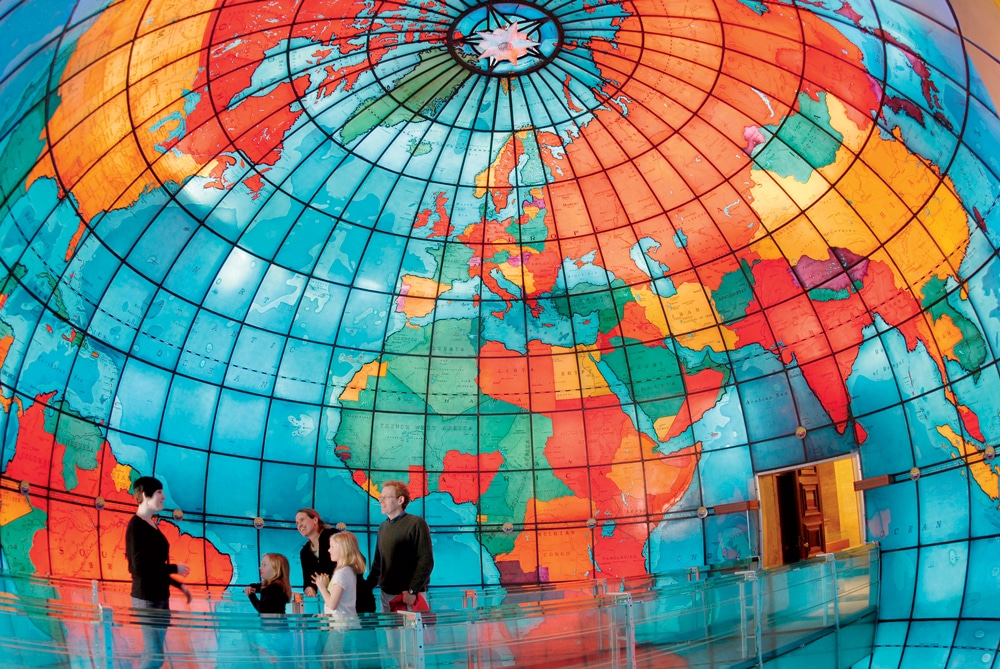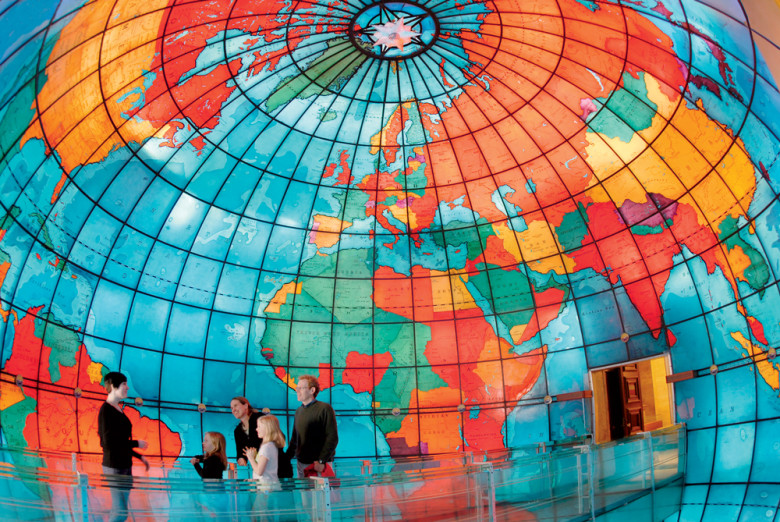The Mapparium | Up Close
When you walk into the Mapparium at the Mary Baker Eddy Library at Boston’s Christian Science Center, you enter a world like no other.

Coffee By Design | Portland, Maine
Photo Credit : Katherine Keenan
Photo Credit : Courtesy of Mary Baker Eddy Library
The Mapparium at the Mary Baker Eddy Library in Boston is a one-of-a-kind structure: the world’s only walk-in, stained-glass globe that allows the surface of the earth to be viewed without distortion. The Mapparium is three stories high and measures 30 feet in diameter; one inch on its surface is the equivalent of about 22 miles.
—
Built and installed for $76,000 (or about $1.3 million today), the Mapparium made its debut on May 31, 1935. Adding a dreamlike glow to the globe’s interior were the more than 300 light bulbs that illuminated the glass from behind. A week after the Mapparium’s opening, there were rumors that city officials had declared the so-called “Glass Room” or “Globe Room” unsafe; however, those rumors were quickly dispelled, and since then more than 10 million guests have visited the Mapparium.
—
The man behind the Mapparium was Chester Lindsay Churchill, architect of the Christian Science Publishing Society building (which would later become the Mary Baker Eddy Library). Inspired by the large globe in the lobby of the New York Daily News building, Churchill wanted to create something to represent The Christian Science Monitor’s global aspirations.
—
For his design, Churchill purchased clear glass from the Hope Glass Company in England and had it shipped to the Rambusch Decorating Company in New York. The Chicago mapmaker Rand McNally provided detailed drawings of the earth’s geographical and political features, which were taped onto the back of each ¼-to-½-inch-thick glass panel and traced onto the front by Rambusch artists. Each panel was then painted with a powdered glass mixture and fired in a kiln to set the color.
—
Originally Churchill wanted visitors to wear felt slippers on the 30-foot-long glass bridge that cuts across the Mapparium. When this proved unrealistic, he reinforced the bridge with ½-inch-thick plate glass.
—
To keep up with changes in global political boundaries, the Mapparium’s glass panels were designed to be replaceable; however, the changes came too rapidly and the replacements proved too costly. Fortunately, by 1966 the Mapparium was considered a historic art object, and all talk of updating the map was dropped.
—
The world inside the Mapparium has stayed stubbornly true to 1935. For instance, Vietnam, Israel, and Burkina Faso are missing—but you can still see Tannu Tuva (a small country wedged between Russia and Mongolia that was dissolved in 1944), along with the bygone regions of Transjordan and French Indochina.
—
After a four-year renovation, the Mapparium had a triumphant reopening in 2002. Among the highlights was the introduction of 206 LED light fixtures: Programmed together, the lights can produce at least 16 million colors.
—
The Mapparium and similar spherical rooms are known as “whispering galleries” because of their unique acoustics. This means that someone speaking quietly at one end of the Mapparium can be heard with perfect clarity by someone at the opposite end. Inside the Mapparium, every visitor’s voice can be heard—symbolizing, in a way, how we all are truly global citizens.








Interesting to know how it was done and the detailed facts. Viewed it years ago and intend to visit it again soon. Thanks
Loved the Mapparium in the 1970’s; will take my grandchildren soon. Thank you so much for the information and wonderful pictures.